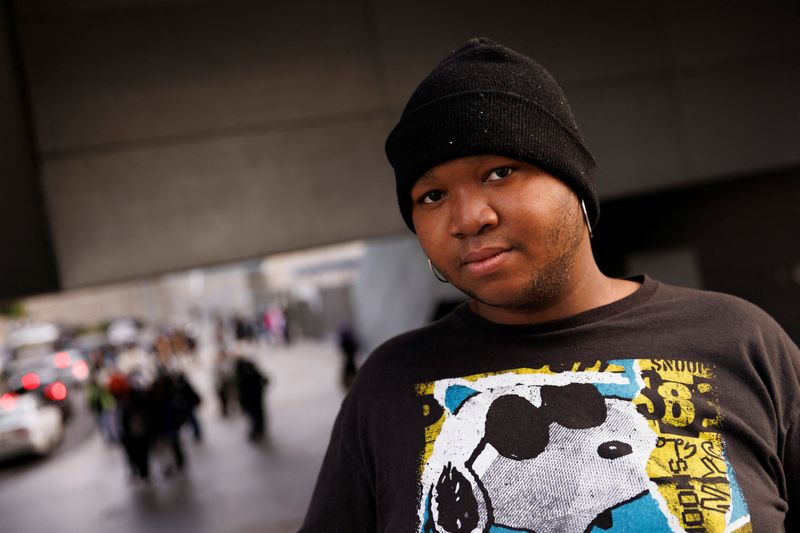
© Reuters. As fellow college students wait within the automotive pick-up line, homeless highschool pupil Frank Hardy, 18, waits to attend his after-school choir class at Ramon C. Cortines College of Visible and Performing Arts, in Los Angeles, California, U.S., December 9, 2021. REUT
2/5
By Daniel Trotta and Richard Cowan
LOS ANGELES/WASHINGTON (Reuters) – Frank Hardy, 18, has been homeless for the previous eight years, shifting out and in of shelters along with his mother, or staying along with his sister’s household whereas his mother has been in jail.
As a part of an financial stimulus package deal to beat the COVID-19 pandemic, the U.S. Congress voted in March to fast-track $800 million and urged educators to maneuver shortly to help the estimated 1.5 million college students like Hardy who’re homeless throughout America.
However the money has but to succeed in the Los Angeles Unified College district, which oversees Hardy’s highschool. Some states and faculty districts rushed their tens of millions to these in want. However California has solely begun disbursing the primary quarter of its allotment of $98.7 million.
The federal authorities approved sending out a primary $200 million in April adopted by the remainder final summer time.
Different large states similar to New York and Florida are even additional behind, having but to ship a dime to the districts, due to bureaucratic logjams or as a result of some districts are ill-equipped even to seek out college students in want.
“Within the early a part of the pandemic, probably the most steady place within the lives of homeless college students – college – disappeared,” stated Barbara Duffield, government director of SchoolHouse Connection, a Washington-based non-profit that addresses pupil homelessness.
Even with the return to in-class studying that adopted preliminary strikes to distant tuition, Duffield stated, “We all know we’re lacking tons of scholars.”
SchoolHouse Connection and the College of Michigan carried out a survey in October of 700 college districts and located a 4% enhance in pupil homelessness, in comparison with the identical interval the yr earlier than the pandemic.
A STORY OF PERSEVERANCE
Hardy is on monitor to graduate in June from the Ramon C. Cortines College of Visible and Performing Arts, even after shedding most of his junior yr to the pandemic, dwelling in a motel and not using a correct web connection and attempting to work off a defective laptop computer.
“I used to be by no means going to let being homeless cease me from reaching what I wish to obtain,” stated Hardy, who goals of changing into knowledgeable singer.
Solely 68% of homeless college students graduated highschool in 2019, some 18 share factors beneath the nationwide common.
Hardy at the moment lives along with his mom Cherie Hardy, 51, at a Folks Aiding the Homeless shelter in Los Angeles.
Cherie Hardy stated she has a file for theft, theft and different offenses, however has straightened her life out partly as a result of “I’ve a son that wants me.”
Many different homeless college students have slipped by means of the cracks.
A minimum of 420,000 homeless college students misplaced contact with their faculties in the course of the pandemic, in line with Republican Senator Lisa Murkowski of Alaska, who together with Democratic Senator Joe Manchin of West Virginia championed the last-minute modification that supplied the $800 million.
Colleges are utilizing the funds to purchase meals, garments and faculty provides. In some instances they’re paying for automotive repairs or automotive insurance coverage to get youngsters get to highschool, or cell telephones so counselors can test in with college students. Cincinnati and Nashville faculties have employed Spanish-speaking social employees.
Cherie Hardy stated she would have welcomed assist shopping for her son garments or a laptop computer.
The Los Angeles Unified College District’s homeless liaison, Angela Chandler, stated the district is exploring hiring workers to establish and attain out to homeless college students, and he or she wish to assist highschool college students proceed their training by funding faculty excursions that may encourage youngsters who in any other case would by no means go to a campus.
“The chances are limitless,” Chandler stated.
However the second largest district within the nation has but to obtain any of the almost $8 million it’s due. Funds from the primary tranche of $883,000 needs to be despatched out “shortly,” a California Division of Training spokesperson stated on Wednesday. A second tranche of $7.1 million will probably be obtained in January. The spokesperson didn’t handle why the method has taken so lengthy.
Florida college districts might solely start making use of for his or her share of $43.8 million as of Dec. 2, a spokesperson for the state’s Division of Training stated.
New York state has but to subject any of its $58.9 million from the brand new funds. The appliance interval of the primary tranche was opened on Dec. 1 and closes on Dec. 22, its Training Division stated.
Even Murkowski’s state Alaska “is just a little bit overwhelmed with all this cash,” stated Dave Mayo-Kiely, a program coordinator for homeless college students and households in Anchorage.
Elsewhere some states have been making use of time-consuming guidelines the federal authorities had stated have been pointless, whereas in others state legislative or native college board approvals have been gradual to come back, in line with the training information website Chalkbeat.
“There are one million issues that go flawed, issues you do not count on to occur,” stated Phyllis Jordan, affiliate director of the FutureEd unbiased assume tank at Georgetown College in Washington, D.C., describing faculties failing to seek out tutors to rent.
Some states have moved extra shortly.
Lisa Phillips, North Carolina’s coordinator for the training of homeless kids and youth, stated her state adopted federal tips and arrange an approval course of earlier than districts made requests. Districts are getting funding inside 10 days of creating a sound utility, she stated.
Greater than half of North Carolina college districts have obtained their share of funds within the second part of this system, with one other 25% being processed.







